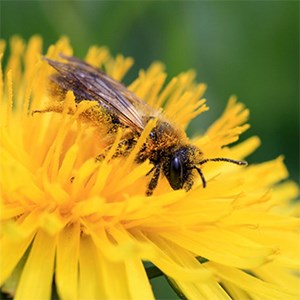Contact
Department of Ecology, NJ, Agricultural Entomology Unit
Riccardo Bommarco, Professor
Department of Ecology, SLU
riccardo.bommarco@slu.se, +46 18 67 24 23

A high diversity of different pollinators and other beneficial organisms in an agricultural landscape leads to a greater harvest. This is shown in an extensive international study where researchers from SLU participated.
Over the past two decades, approximately 20 percent of the Earth's cultivated surfaces have become less productive. According to the latest report from the United Nations’ Food and Agriculture Organization (FAO), humans are the culprit - we have not done enough to protect nature's biodiversity. An international research team coordinated by the University of Würzburg and Eurac Research confirmed the advantages of biodiversification: agricultural fields with greater biodiversity are better protected from harmful insects, promote pollination and produce higher yields.
Ecologists and biologists compared data of about 1,500 agricultural fields around the world: from corn fields in the American plains to oilseed rape fields in southern Sweden, to coffee plantations in India, mango plantations in South Africa and cereal crops in the Alps. They analyzed two ecosystem services (i.e., processes regulated by nature that are beneficial and free for humans): the pollination service provided by wild insects and biological pest control service, which is the ability of an environment to use predatory arthropods present in the ecosystem to defend itself from harmful insects.
In heterogeneous landscapes — where the variation of crops, hedges, trees and meadows is greater — wild pollinators and "beneficial" insects are more abundant and diversified. Not only do pollination and biological control increase, so does the crop yield.
Monocultures give negative effects on pollination and loss of natural enemies
On the other hand, monocultures are the cause of roughly a third of the negative effects on pollination that result from landscape simplification (measured by loss of ‘pollinator richness’). This effect is even greater with the control of harmful insects, where loss of ‘natural enemy richness’ represents 50 per cent of the total consequences of landscape simplification.
– Our study shows that biodiversity is essential to ensure the provision of ecosystem services and to maintain a high and stable agricultural production, says Mattias Jonsson, director of the Centre for Biological Control (CBC) and researcher at the Department of Ecology at SLU. Mattias is one of the authors behind the study.
– For example, a farmer can depend less on pesticides to get rid of harmful insects if natural biological controls are increased through higher agricultural biodiversity, continues Mattias.
The researchers recommend protecting environments whose health is maintained through biodiversity and to diversify crops and landscapes as much as possible.
– Under future conditions with ongoing global change and more frequent extreme climate events, the value of farmland biodiversity ensuring resilience against environmental disturbances will become even more important. Our study provides strong empirical support for the potential benefits of new pathways to sustainable agriculture that aim to reconcile the protection of biodiversity and the production of food for increasing human populations, says Riccardo Bommarco, Professor at the Department of Ecology at SLU and another of the authors behind the study.
Riccardo Bommarco, Professor
Department of Ecology, SLU
riccardo.bommarco@slu.se, +46 18 67 24 23